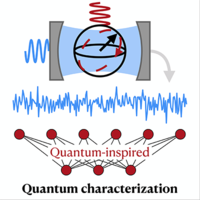Abstract
Machine learning (ML) is a promising approach for performing challenging quantum-information tasks such as device characterization, calibration, and control. ML models can train directly on the data produced by a quantum device while remaining agnostic to the quantum nature of the learning task. However, these generic models lack physical interpretability and usually require large datasets in order to learn accurately. Here we incorporate features of quantum mechanics in the design of our ML approach to characterize the dynamics of a quantum device and learn device parameters. This physics-inspired approach outperforms physics-agnostic recurrent neural networks trained on numerically generated and experimental data obtained from continuous weak measurement of a driven superconducting transmon qubit. This demonstration shows how leveraging domain knowledge improves the accuracy and efficiency of this characterization task, thus laying the groundwork for more scalable characterization techniques.
3 More- Received 10 August 2021
- Accepted 12 November 2021
DOI:https://doi.org/10.1103/PRXQuantum.2.040355
Published by the American Physical Society under the terms of the Creative Commons Attribution 4.0 International license. Further distribution of this work must maintain attribution to the author(s) and the published article's title, journal citation, and DOI.
Published by the American Physical Society
Physics Subject Headings (PhySH)
Popular Summary
The quest for the realization of a fault-tolerant quantum computer is gathering considerable attention. A key challenge in reaching this goal lies in our ability to accurately understand and characterize the dynamics of current noisy quantum devices. In practice, this is a complex task, which requires significant experimental resources. Indeed, the existing statistical methods are prohibitively expensive such that new techniques are required, among which machine learning is particularly appealing. Here, we show on experimental data that quantum-aware machine-learning models enable the efficient and accurate characterization of a quantum device.
We introduce two key ideas to realize this characterization. First, we tailor the way machine-learning models are trained and, second, we design those models such as to take advantage of specific quantum features describing the devices of interest. We therefore use our domain knowledge of the quantum characterization task to make the most out of the limited experimental data that can be acquired in the laboratory. By applying our method to numerically generated and experimental data, we show that we can achieve a physical characterization of a small quantum device, a superconducting qubit, that is more accurate and efficient than using state-of-the-art machine-learning methods. Our work shows that leveraging quantum features in a machine-learning approach is beneficial to gain physical insights about the dynamics of the device, which are instrumental for improving our control over the engineered quantum system.
These results are an important step toward utilizing quantum features in machine learning to perform challenging quantum-information processing tasks. We anticipate that this approach will significantly enhance our abilities to learn from the data produced by quantum devices and to use this information to perform accurate quantum computations, for example, using optimal controls and feedback strategies.



